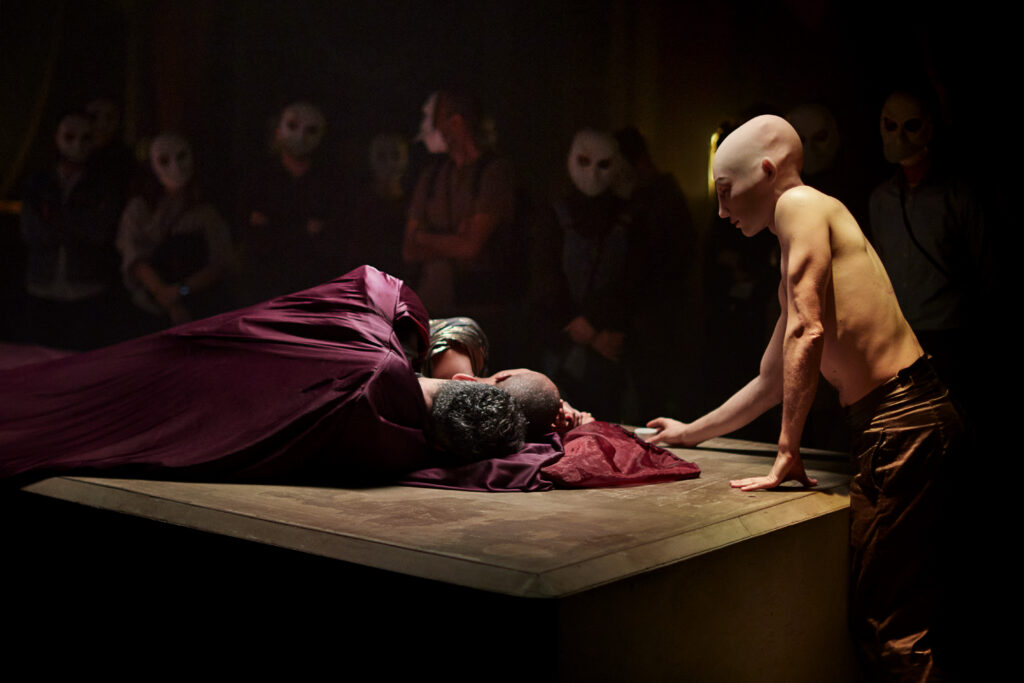One Cartridge Place, London – booking until 4 December 2022
Reviewed by Alun Hood
4****
You never forget your first Punchdrunk. Felix Barrett and Maxine Doyle’s epoch-making shows have transformed expectations of what immersive, site-specific theatre can achieve, in terms of scale, production values, all-encompassing design and attention to detail, and audience engagement. To experience one – you can’t just watch a Punchdrunk production, not least because you’ll be on your feet and on the move pretty much the whole time – is to go on a complete sensory journey, one where you decide which story arcs and characters to watch and follow, which of the stunningly realised sets to explore, and to be utterly transported. With The Burnt City, their biggest show to date, they take on Greek myth, although the aesthetic is anachronistic: boho chic meets old school Hollywood glamour meets monochrome starkness: there’s not a floaty tunic in sight, although there is a fair bit of blood and gore.
Part of the fun comes at the end, seeing the disorientation of audience members/participants removing their masks and readjusting to being back in the “real” world, as opposed to the elaborately curated one the Punchdrunk collective have manifested. For the uninitiated: everybody is provided with a rigid, bone-white mask for the duration, and the effect is curiously liberating while at the same time impeding peripheral vision and spatial awareness in ways that some may find discomfiting. Indeed, one of the enduring images I’ve taken away from each Punchdrunk show I’ve been to, is of distant flotillas of these pearlescent white masks moving at speed through the gloom as a host of audience members pursue their chosen character to a different part of the vast space and the next instalment of that particular plot strand.
Linear storytelling isn’t the point here, each gargantuan production being a distillation of it’s source material (their last big London project, 2014’s The Drowned Man, performed across multiple transformed floors of a disused Paddington post office was inspired by Buchner’s Woyzeck, while their ongoing NYC long runner Sleep No More is a riff on Macbeth, turning a dilapidated Manhattan warehouse into an elegant but demonically possessed 1930’s hotel) rather than a straightforward adaptation. As each show is virtually wordless (the Punchdrunk language is an intoxicating combination of atmosphere, music, mime and modern dance), it may be worth doing a bit of research on the background before you set out. I certainly found myself wishing I’d boned up on Greek drama, specifically Aeschylus’s Agamemnon and Euripides’s Hecuba which are the basis for The Burnt City, housed in Punchdrunk’s new HQ, a pair of former military arsenal buildings near the Thames.
Certain moments from the stories – Agamemnon’s sacrifice of his daughter Iphigenia to appease the Gods of War, Clytemnestra’s revenge and her dalliance with Aegisthus – are fairly clear but there are times when it’s pretty impossible to work out what’s going on. Plus if you stay in one spot for too long you’ll experience the same sections more than once, as though on a loop. There’s a danger of FOMO setting in – it’s impossible to take the whole thing in on one visit – also a sense of ennui and disbelief that you’ve just spent minutes watching somebody make a cup of tea or a soldier climb a ladder in slo mo, or witnessed a plastic-clad pair cavort with what looks like offal. Whether or not that bothers you depends on the extent to which you surrender to the overall Punchdrunk vision. If it all takes itself very seriously, well, Greek Tragedy was never a barrel of laughs.
Technically, it is astounding: from Stephen Dobbie’s doomy, overwhelming score, drawing on everything from trance to Charleston to a lush Hans Zimmer-like orchestral swell, to David Israel Reynoso’s costume designs and the gorgeous, if occasionally too dim, lighting (by FragmentNine, Ben Donoghoe and Felix Barrett), everything pretty much takes the breath away. Maxine Doyle choreographs and her jagged, adrenalised creations for the humans in distress contrast tellingly with the fluid, other-worldly dynamism of the Fates, plus it’s an authentic thrill to experience dance at such close quarters. The cast are a sinewy, beautiful bunch, with presence and athleticism to spare, but they rotate parts so, unless you’re a clued-up regular, you don’t know who you’re watching in which role.
Designers Felix Barrett, Livi Vaughan and Beatrice Minns have divided the vast area into two very specific worlds. Greece is austerely, chillingly magnificent: on a mezzanine, Agamemnon’s Mycenae palace combines brutality and luxury while below a wide open space suggests a battlefield and wasteland, with massive wrought iron structures scattered about like the prows of abandoned ships, and the two levels are connected by an epic staircase, the like of which hasn’t seen so much action since Sunset Boulevard. By contrast, Troy is a funky, grungy, densely packed neon-edged city, full of weird but colourful shops, bars, hotels, and a kind of desperate, apocalyptic energy. There’s even a night club, complete with fully stocked bar, where a glorious Black diva belts out a version of New Order’s ‘Blue Monday’. There is an all-pervasive sense though, in the astonishingly detailed installations and tableaux vivants, of urban lives being abandoned in a panic, and of grim resignation from the humans left behind to face an oncoming storm of the Greek invasion, and it’s hard not to contextualise this with the current events in Ukraine.
If I came away from The Burnt City impressed rather than moved, I am still, a day later, haunted by individual images: Iphigenia’s broken body splayed across the top of a gantry, a pile of bones in front of a makeshift altar, Agamemnon processing up the epic staircase in a never-ending blood red cloak, or the ghostly contortions of the nearly naked company processing back down it at the conclusion before exploding into a whirring, trance-like ritualistic circular dance as snow falls from above. Shatteringly powerful moments sit next to sections that are frustratingly elliptical. The best approach is to let it just wash over you…and wear comfy shoes. Punchdrunk are back, and it’s epic.

